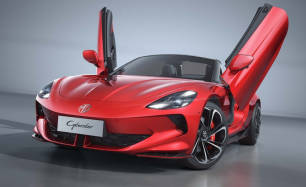There’s good news and bad news about the Cyberster from behind the wheel.
The good news is it’s quite easy to drive this thing very fast.
The bad news is it feels like it would be quite easy to get sick of as a day-to-day car, depending on your situation.
The first thing I noticed is the seat feels a bit high, even at its lowest setting. That's likely due to the placement of the battery pack under the floor of of the car.
Following that, if you’re taller than me (I'm five foot 11), it feels like the wrong road surface will have you nudging your head into the roof liner.
That mechanical roof should take about 15 seconds to lower or raise, and that can be done at speeds up to 50km/h.
It could be a symptom of trying to keep 1985kg tied down, but some of Melbourne's highways and arterial roads between 70 and 100km/h had the Cyberster bobbing quite a bit.
But the suspension doesn't let individual bumps intrude too much into the cabin, so it’s not all bad.
Similarly, there’s good and bad when it comes to the steering and braking.
The first being that the steering seems pretty accurate, even though the feedback is a bit numb.
The braking on the other hand is handled by some pretty capable Brembos up front that pull the heavy roadster up quickly, but don’t always clamp as hard as you might expect when approaching a traffic light at 60km/h.
But stopping’s one thing, and going’s another.
There are three main drive modes, Comfort, Sport, and Super Sport, which mainly alter the acceleration intensity. And they feel well calibrated.
Comfort keeps things calm and cruisy, Sport is plenty for the road, and Super Sport has the potential to draw the attention of the authorities.
There’s good adjustability when it comes to regen braking, and even a decent single-pedal driving mode.
Aside from a couple of particularly heinous roads, the Cyberster held mostly flat when cornering at high speeds, but the potential for its suspension to let its wheels lose their footing might - or should - stop you from pushing the MG too hard.
At high speeds, there’s a bit of wind noise that you really can’t complain about if you’ve just purchased a drop-top, but the noise, vibration and harshness is decent, all things considered.
My only gripe with the interior fit out is that the passenger seat wobbles a little, and rattles on the surface behind it before moving it forward.
It’s impressive what this car can do in terms of performance, it’s just a shame it’s not more playful.

